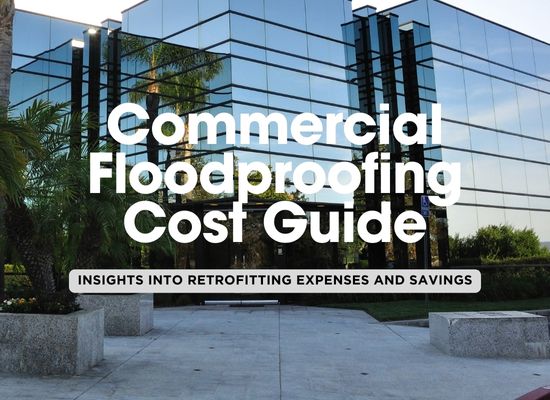As floods become more frequent and severe, retrofitting buildings for flood resilience is no longer optional for many property owners. While retrofitting can prevent catastrophic damage and lower long-term costs, the upfront expenses can vary widely. Understanding the key cost drivers can help you plan effectively and make informed decisions. Here are the top factors that influence the cost of flood-resilient retrofitting.
1. Elevation of the Structure ⬆️
- What it is: Elevating a building above the base flood elevation (BFE) is one of the most effective ways to protect it from flooding. This involves lifting the structure and creating a new, higher foundation.
- Cost Factors: Costs depend on the size of the building, its weight, and the type of foundation required. Homes on slab foundations are generally more expensive to elevate than those on pier or crawl space foundations.
- Estimated Costs: Lifting a small home can range from $30,000 to $100,000, while larger structures may exceed $250,000.
- Tip: Before elevating, confirm your area’s BFE and local regulations to avoid unnecessary costs or compliance issues.
2. Dry Floodproofing Techniques 🚪
- What it is: Dry floodproofing involves sealing a building to prevent water from entering. This can include waterproof coatings, barriers, and specialized doors or windows.
- Cost Factors: Costs vary based on the building’s surface area and the types of materials used. Retrofitting older buildings may require extensive preparation, increasing costs.
- Estimated Costs: Dry floodproofing typically ranges from $10,000 to $50,000 for residential buildings, depending on the complexity.
- Tip: Focus on protecting key entry points like doors, windows, and utility openings for maximum cost-effectiveness.
3. Wet Floodproofing Measures 💧
- What it is: Wet floodproofing allows water to enter a building but minimizes damage by using flood-resistant materials and elevating critical systems. This is often used in non-livable areas like basements and garages.
- Cost Factors: Costs depend on the type of materials needed (e.g., water-resistant drywall, concrete floors) and the extent of system elevation (e.g., HVAC or electrical panels).
- Estimated Costs: Wet floodproofing ranges from $5,000 to $20,000 for most residential properties.
- Tip: Use wet floodproofing in areas below the BFE that are less critical to daily living, such as storage spaces, to balance cost and functionality.
4. Reinforcement of Structural Integrity 🏠
- What it is: Strengthening a building’s structure to withstand floodwaters, currents, and debris impacts. This includes reinforcing walls, installing additional bracing, and upgrading foundation materials.
- Cost Factors: The type of building materials, the extent of the reinforcement needed, and whether the structure was originally built to modern codes all impact the cost. Older buildings tend to require more extensive (and expensive) upgrades.
- Estimated Costs: Structural reinforcement can range from $10,000 to $75,000 depending on the size and condition of the building.
- Tip: Conduct a thorough structural assessment before beginning any retrofitting project to identify weak points and prioritize cost-effective improvements.
5. Relocation or Elevation of Utilities ⚡🚿
- What it is: Moving critical utilities like electrical panels, water heaters, HVAC systems, and plumbing to higher, safer levels within the building or to an elevated platform outside.
- Cost Factors: Costs depend on the complexity of rerouting utility lines, the types of systems being relocated, and whether existing equipment needs replacement. Labor-intensive jobs in older homes with outdated systems can increase expenses.
- Estimated Costs: Utility relocation typically costs between $5,000 and $20,000, though complex projects may exceed $30,000.
- Tip: Combine utility relocation with other retrofitting efforts to minimize labor costs and disruption.
6. Installation of Sump Pumps and Drainage Systems 💧🔄
- What it is: Installing or upgrading sump pumps, French drains, and other drainage solutions to manage and redirect water away from the building. These systems prevent water buildup during heavy rains or flooding events.
- Cost Factors: Costs vary depending on the size of the area to be drained, the type of pump, and whether additional excavation or trenching is required. Backup power systems for sump pumps can add to the expense.
- Estimated Costs: Installing a sump pump ranges from $3,000 to $6,000, while more extensive drainage systems can cost $10,000 or more.
- Tip: Invest in a battery or generator backup for your sump pump to ensure it works during power outages caused by storms.
7. Compliance with Local Floodplain Regulations 📜
- What it is: Ensuring retrofitting efforts align with local floodplain management ordinances and building codes. Failure to comply can lead to fines, higher insurance premiums, or denial of permits.
- Cost Factors: Costs arise from obtaining permits, engineering consultations, and modifying plans to meet regulations. If new flood maps are issued, you may need to upgrade previous work to comply.
- Estimated Costs: Permit and compliance costs can range from $1,000 to $10,000, depending on the complexity of local regulations.
- Tip: Work with professionals familiar with your local floodplain ordinances to streamline the process and avoid costly mistakes.
8. Flood-Resistant Materials Selection 🛠️
- What it is: Replacing traditional materials with flood-resistant options like waterproof insulation, pressure-treated wood, and non-porous flooring. These materials minimize damage and reduce cleanup costs after flooding.
- Cost Factors: The price of flood-resistant materials is generally higher than conventional materials. Retrofitting older buildings can also involve additional labor costs for removing and replacing existing materials.
- Estimated Costs: Flood-resistant materials typically increase project costs by 20-30%. For example, waterproof flooring can cost $6-$12 per square foot compared to $3-$6 for traditional options.
- Tip: Prioritize high-risk areas like basements and ground floors for flood-resistant upgrades to maximize your budget’s impact.
9. Labor Costs 🧑🔧
- What it is: The expense of skilled professionals needed for retrofitting projects, such as structural engineers, contractors, electricians, and plumbers. Labor costs often constitute a significant portion of the overall budget.
- Cost Factors: Costs vary depending on the complexity of the work, the availability of local professionals, and market demand. Emergency retrofits after a disaster may incur premium rates due to high demand.
- Estimated Costs: Labor can account for 30-50% of the total project cost. For example, installing a sump pump may cost $1,500 for materials but $3,000-$5,000 for labor.
- Tip: Obtain multiple quotes and verify contractor credentials to ensure quality work at a competitive price.
10. Advanced Flood Mitigation Technologies 🌐
- What it is: Incorporating cutting-edge solutions like automated flood barriers, IoT-based water sensors, and flood alert systems. These technologies enhance flood preparedness and reduce the risk of severe damage.
- Cost Factors: Advanced technologies often come with high upfront costs but can offer long-term savings through reduced insurance premiums and improved protection.
- Estimated Costs: Automated barriers range from $20,000 to $100,000, while IoT sensors and monitoring systems can cost $500-$5,000 depending on coverage and features.
- Tip: Consider technologies that integrate with your existing systems to avoid redundancy and maximize efficiency.
Retrofitting buildings for flood resilience is an investment in safety, sustainability, and long-term cost savings. While the upfront costs may seem daunting, understanding the primary cost drivers can help you prioritize your efforts and create a practical, effective plan. Whether elevating your home or integrating advanced technologies, every step toward resilience makes a difference.



